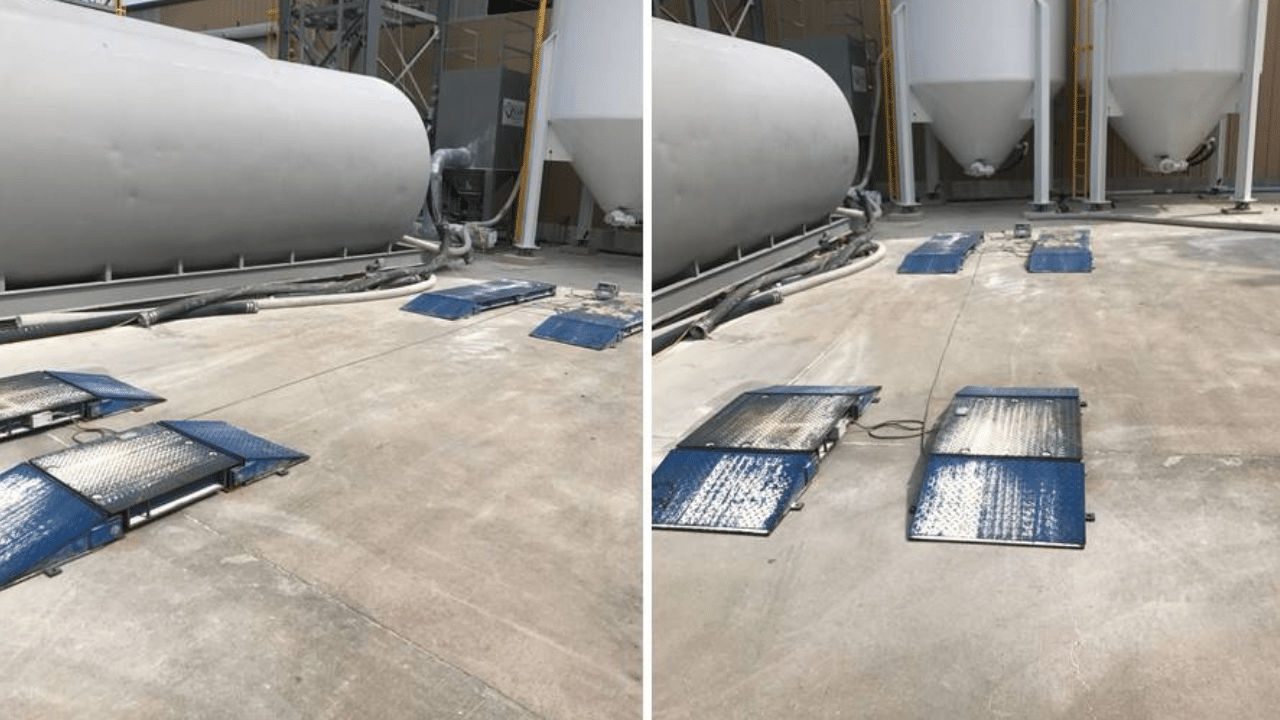
When working in the trucking industry, ensuring your truck’s load is balanced and meets safety standards isn’t just about efficiency—it’s also about avoiding costly fines.
Today, we’ll explore the fascinating world of trailer scales, from the rugged pits of permanent installations to the swift mobility of portable units.
Join us as we dive into the mechanics and merits of different trailer scales and learn how to choose the right one for your business’s unique needs.
Types of Trailer Weight Scales
Trailer scales are specialized devices designed to measure the weight of trucks and their attached trailers accurately.
They can come in different types according to the needs of each application.
Permanent Trailer Scales
Pit-Type Scales
These scales are installed in a concrete pit to flush the scale platform with the ground level. This configuration allows for easy access and can handle a high volume of traffic.
Pit-type scales are ideal for locations where space is limited and are often used in commercial weighing stations.
They can be axle scales, varying between different lengths or weighbridge scales, full size ones that are also legal-for-trade.
Above-Ground Scales
Above-ground, also known as surface-mounted scales, do not require a pit and are easier to install and maintain than pit-type scales. They are raised slightly above the ground and might require ramps for truck access.
This type of scale can also measure trucks by axle or the full length of the vehicle, depending on whether it needs to be a legal-for-trade measurement or not.
Portable Trailer Weight Scales
Axle Scales
Portable axle scales are designed for temporary or mobile applications. They can be placed directly on a flat surface, and trucks can drive over them to weigh one axle at a time.
These scales are compact, easy to transport, and set up, making them ideal for construction sites or temporary checkpoints.
Ultraslim Wheel Load Scales
Wheel weighers are highly portable scales, each capable of weighing individual wheels or axles. Wheel weighers are typically used in field service applications, enforcement for compliance with weight regulations, and by cargo companies to prevent overloading.
They are usually made from rugged materials like aluminum for durability and ease of movement.
Portable Weighbridge Scales
Portable weighbridge scales, or full platform portable scales, resemble traditional permanent scales but are designed for temporary installation. They can handle the full truck and trailer and provide a weight reading in one operation.
Full-platform portable scales are suitable for use in logging, agriculture, or any industry requiring mobile weighing solutions.
How to Weighing Your Truck with a Loaded Trailer
Preparation for Weighing Your Truck
Before positioning your truck on the scale, ensure the tire pressure is even, and the load is distributed uniformly.
Furthermore, always verify that the scales are certified and regularly calibrated according to industry standards, guaranteeing the precision needed for compliance and safety.
Step-by-Step Guide to Weighing Your Truck with a Loaded Trailer
Step 1: Preparation Before Arrival
- Check Vehicle Condition: Ensure the truck and trailer are in good working condition. Check that the brakes, tires, and suspension are all functioning properly.
- Verify Load Distribution: Ensure the load is evenly distributed within the trailer to avoid inaccuracies in weight measurements.
Step 2: Pre-Weighing Checklist
- Check Tire Pressure: Ensure all tires are inflated to the recommended levels to avoid discrepancies in weight readings.
- Remove Unnecessary Items: Clear the truck and trailer of any unnecessary items that could add weight.
Step 3: Positioning the Truck and Trailer
- Drive Onto the Scale: Slowly drive the truck onto the scale to avoid shifting the load.
- For a Full-Length/Weighbridge Scale: Ensure that the entire vehicle, including all axles of both the truck and trailer, is completely on the scale.
- For an Axle or Axle Group Scale: You will need to repeat this procedure for each set of axles.
- For an Ultraslim Scale: Another person must assist to ensure that the truck tire is fully positioned on top of the scale.
Step 4: Conducting the Weighing
- Stabilize the Truck: Come to a complete stop and set the parking brake. Unless instructed otherwise, the vehicle should be stationary with the engine running.
- Record the Weight: Wait for the signal from the weigh station operator or the display to confirm the weight has been recorded.
Step 5: Adjusting Load if Necessary
- Check Weight Tickets: Review the weight ticket or display to ensure the weight is within legal limits.
- Adjust the Load: If the weight exceeds legal limits or seems unevenly distributed, adjust the load as needed. This may involve shifting goods within the trailer or removing some items.
Step 6: Finalizing the Process
- Complete Documentation: Ensure all documentation, including the weight ticket, is accurate.
- Exit the Scale: After completing all checks and the load is confirmed to be within legal limits, carefully drive off the scale.
Step 7: Post-Weighing Checks
- Review and Plan: Based on the weight information, plan your route, especially if any weight-limited roads or bridges exist.
- Regular Maintenance: Regularly maintain the truck and trailer to ensure consistent weighing results in the future.
This guide should help drivers and fleet operators ensure their trucks are weighed accurately and comply with legal requirements, providing a clear and straightforward process for weighing trucks with loaded trailers.
Common Mistakes to Avoid When Weighing
- Ignoring Calibration: Not regularly calibrating your scales can lead to inaccurate measurements that may result in legal penalties.
- Poor Positioning: Incorrect truck positioning on the scale can cause part of the load to be off the scale, leading to faulty weight data.
- Neglecting Tire Pressure: Uneven tire pressure can affect the scale’s readings. Always check it before driving onto the scale.
Optimizing Your Weighing Operations
Incorporating technology such as mobile applications or automated systems can streamline the weighing process, reducing time and potential human error.
As we pull over at the end of our journey through the diverse landscape of trailer scales, it’s clear that the path to choosing the right scale is paved with knowledge and strategic thinking.
Whether it’s the steadfast reliability of pit-type scales under constant traffic or the flexible prowess of portable weighbridges in the field, each type plays a pivotal role in the logistics that drive industries forward.
By aligning the scale’s capabilities with your business’s demands, you not only comply with the law but propel your operations toward greater efficiency and profitability.
Equip wisely, weigh accurately, and drive your business to its peak performance.
Weigh Your Options: A Guide to Finding the Perfect Trailer Scale
Don’t let the weight of uncertainty slow you down.
Contact Massload today to discover the perfect trailer scale configuration for your business.
Our experts are here to guide you through the options and help you select a solution that maximizes efficiency, compliance, and performance.


